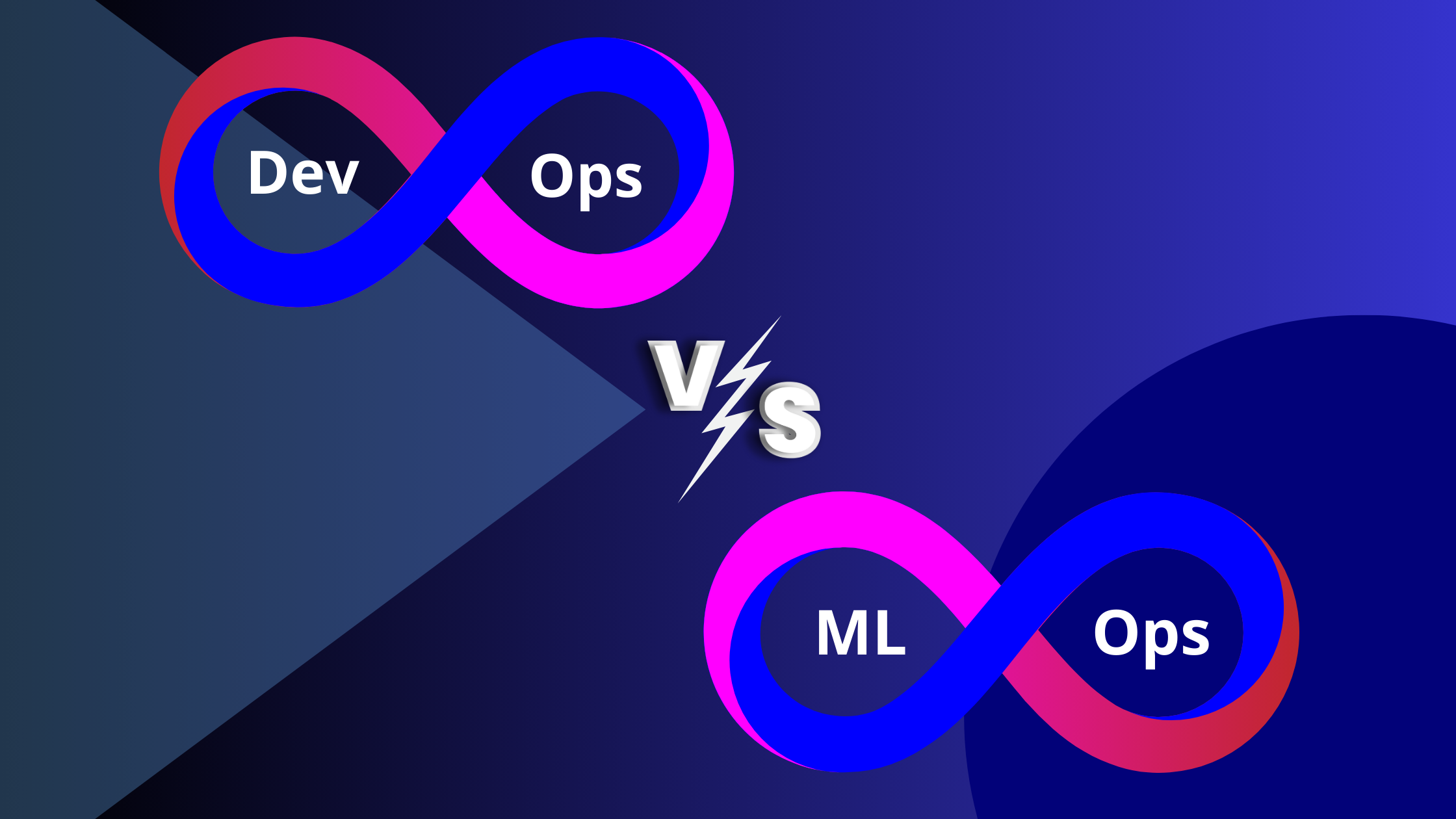In today’s rapidly evolving technological landscape, organizations are under increasing pressure to deliver software and AI-powered products and services at an accelerated pace. To meet these demands, two distinct yet interconnected disciplines have emerged: DevOps and MLOps.
DevOps, a combination of development and operations, focuses on streamlining the software development lifecycle. MLOps, on the other hand, is specifically tailored to the unique challenges of machine learning, encompassing the entire lifecycle from data ingestion to model deployment and monitoring.
While these practices share common goals of automation, collaboration, and efficiency, they also have distinct characteristics. This article delves into the nuances of MLOps and DevOps, comparing and contrasting their key principles, methodologies, and objectives to provide a comprehensive understanding of these critical disciplines.
By understanding the differences and similarities between MLOps and DevOps, organizations can effectively leverage these practices to optimize their software development and AI initiatives.
What is DevOps?
DevOps is a set of practices that combines software development (Dev) and IT operations (Ops) to shorten the software development lifecycle while delivering features, fixes, and updates frequently in close alignment with business objectives. It promotes a collaborative culture between development and operations teams by automating infrastructure provisioning, testing, deployment, and monitoring.
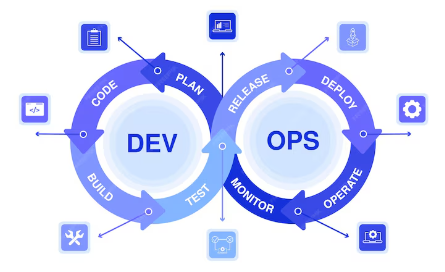
Core Principles of DevOps
- Collaboration: Fostering teamwork and communication between development and operations teams.
- Automation: Automating repetitive tasks to increase efficiency and reduce errors.
- Continuous Integration and Continuous Delivery (CI/CD): Implementing automated pipelines for building, testing, and deploying software.
- Infrastructure as Code (IaC): Managing infrastructure using code for consistency and reproducibility.
- Monitoring and Logging: Tracking system performance and identifying issues.
Challenges of Implementing DevOps
- Cultural Shift: Overcoming traditional silos between development and operations teams.
- Toolchain Complexity: Selecting and integrating the right DevOps tools can be challenging.
- Skill Gap: Finding skilled DevOps professionals can be competitive.
- Security: Ensuring security throughout the DevOps pipeline is critical.
Best Practices for DevOps
- Start Small: Begin with simple automation and gradually expand.
- Measure and Iterate: Continuously monitor and improve DevOps processes.
- Focus on Collaboration: Build strong relationships between development and operations teams.
- Automate Everything Possible: Leverage automation tools to streamline workflows.
- Embrace a Culture of Continuous Improvement: Foster a learning and experimentation mindset.
By adopting DevOps principles, organizations can accelerate software delivery, improve quality, and enhance collaboration.
What is MLOps?
MLOps, a portmanteau of Machine Learning and Operations, is a set of practices that aim to streamline the development and deployment of machine learning models. It bridges the gap between data scientists and IT operations, fostering collaboration and efficiency. Essentially, MLOps is about creating a production-ready ML pipeline that can be reliably deployed and maintained.
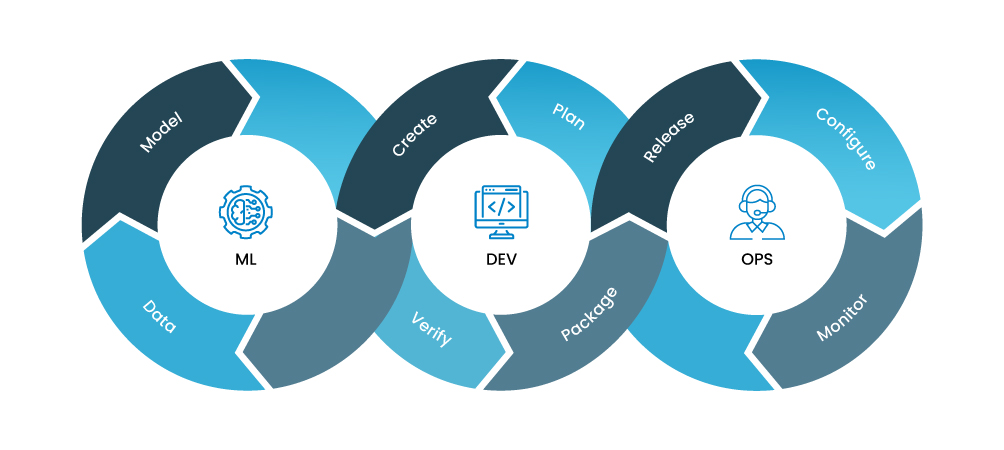
Core Components of MLOps
- Data Management: Effective MLOps requires robust data pipelines, including ingestion, cleaning, and preparation.
- Model Development and Training: Data scientists build and train machine learning models using various algorithms and techniques.
- Model Deployment: Integrating trained models into production environments for real-time or batch predictions.
- Model Monitoring and Retraining: Continuously tracking model performance and retraining as needed.
- Model Governance: Ensuring model reliability, fairness, and compliance with regulations.
Challenges of Implementing MLOps
Despite its benefits, implementing MLOps comes with challenges:
- Data Quality: Ensuring data accuracy, consistency, and completeness is crucial for model performance.
- Model Complexity: Managing complex models with numerous hyperparameters can be daunting.
- Infrastructure: Scaling ML workloads requires robust infrastructure and efficient resource utilization.
- Talent Acquisition: Finding skilled MLOps professionals can be challenging.
- Organizational Culture: Building a collaborative culture that supports MLOps is essential.
Best Practices for MLOps
- Prioritize Data Quality: Invest in data cleaning, validation, and enrichment.
- Automate ML Pipelines: Use CI/CD tools to streamline the development and deployment process.
- Monitor Model Performance Closely: Implement robust monitoring and alerting systems.
- Version Control for Models and Data: Track changes to ensure reproducibility.
- Collaboration: Foster collaboration between data scientists and IT operations.
- Experimentation and Iteration: Embrace a culture of experimentation and continuous improvement.
By following these best practices, organizations can effectively implement MLOps and unlock the full potential of machine learning.
A Comparative Table: Similarities and Differences Between MLOps and DevOps
Core Similarities
| Feature | DevOps | MLOps |
| Goal | Streamline software development and delivery | Optimize machine learning model development and deployment |
| Focus | Software development lifecycle | Entire machine learning lifecycle |
| Key Practices | CI/CD, Infrastructure as Code, Version Control, Monitoring, Collaboration | CI/CD, Infrastructure as Code, Version Control, Monitoring, Collaboration, Data Management, Model Management |
| Challenges | Cultural shift, toolchain complexity, security | Data quality, model complexity, infrastructure, talent gap, ethical considerations |
| Benefits | Faster time-to-market, improved quality, increased efficiency | Accelerated ML model development, better model performance, enhanced business value |
Key Differences
| Feature | DevOps | MLOps |
| Core Components | Build, test, deploy, operate, monitor | Data ingestion, model development, training, deployment, monitoring, retraining |
| Primary Artifacts | Code, infrastructure, configurations | Data, models, pipelines, experiments |
| Metrics | Deployment frequency, lead time, mean time to recovery (MTTR) | Model accuracy, precision, recall, F1-score, model drift |
| Tools and Technologies | Jenkins, Docker, Kubernetes, Ansible | MLflow, Kubeflow, TensorFlow Extended, DVC, Git |
| Skillset | Software development, system administration, network engineering | Data science, machine learning, software engineering, DevOps |
Detailed Comparison
| Feature | DevOps | MLOps |
| Data Management | Minimal focus | Central and critical |
| Model Development | N/A | Core component |
| Model Deployment | Deployment of software applications | Deployment of ML models into production |
| Model Monitoring | Limited to application performance | Comprehensive monitoring of model performance, data quality, and infrastructure |
| Experimentation | Less emphasis on experimentation | Extensive experimentation and tracking |
| Iteration | Continuous improvement cycles | Frequent model retraining and updates |
| Ethical Considerations | Primarily focused on security and privacy | Includes fairness, bias, and transparency |
Visual Representation

The Venn diagram illustrates the shared and unique aspects of DevOps and MLOps. The overlapping area represents the common practices, while the distinct sections highlight the specific focus of each discipline.
DevOps Principles Applied to MLOps
DevOps has established a strong foundation for efficient software delivery, and many of its core principles can be directly applied to MLOps. By integrating these practices, organizations can streamline the machine learning lifecycle and achieve faster time-to-market.
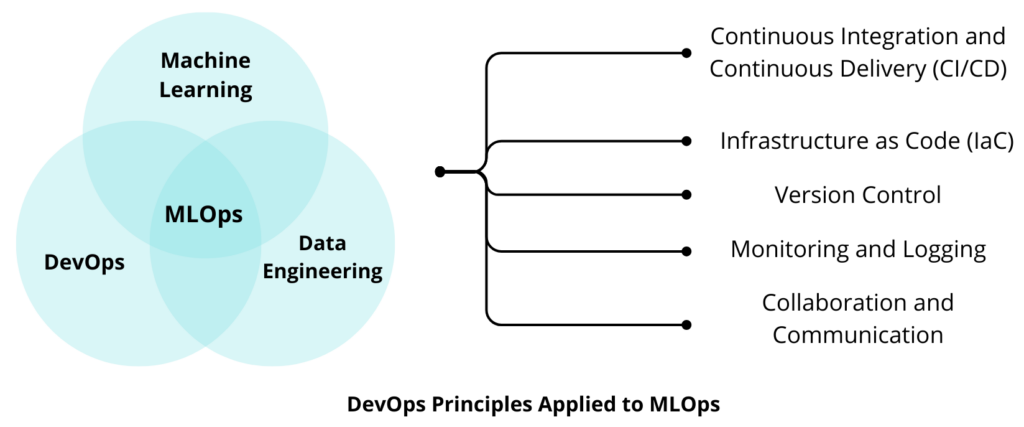
Continuous Integration and Continuous Delivery (CI/CD)
A cornerstone of DevOps, CI/CD is equally crucial for MLOps. By automating the build, test, and deployment processes for machine learning models, organizations can accelerate development cycles, improve quality, and reduce errors.
- DevOps: CI/CD in DevOps focuses on automating the build, test, and deployment of software applications. This involves practices like version control, automated testing, and continuous integration servers.
- MLOps: CI/CD is extended to encompass the entire machine learning lifecycle, including data ingestion, model training, validation, and deployment. This requires specialized tools and platforms that can handle the unique characteristics of ML models.
Infrastructure as Code (IaC)
IaC enables the management of infrastructure using code, promoting consistency and reproducibility. In both DevOps and MLOps, IaC is essential for provisioning and managing the necessary compute resources.
- DevOps: IaC is used to automate the provisioning and configuration of servers, networks, and storage for application deployment.
- MLOps: IaC extends to managing ML infrastructure, including compute resources, ML frameworks, and data platforms. Additionally, IaC can be used to define and manage ML experiments, ensuring reproducibility.
Version Control
Effective version control is fundamental for both DevOps and MLOps. By tracking changes to code, data, and models, organizations can collaborate efficiently, reproduce experiments, and roll back to previous versions if necessary.
- DevOps: Version control is primarily used to manage code and configuration files.
- MLOps: Version control extends to data, models, ML pipelines, and experiments, requiring specialized tools like DVC (Data Version Control) to handle large datasets and model artifacts.
Monitoring and Logging
Comprehensive monitoring is essential for identifying issues, optimizing performance, and ensuring compliance. Both DevOps and MLOps rely on robust monitoring to track system health, application performance, and user experience.
- DevOps: Monitoring focuses on application performance, infrastructure health, and user experience.
- MLOps: Monitoring extends to include model performance metrics, data quality, ML pipeline health, and infrastructure utilization. Additionally, MLOps requires specialized monitoring tools to track model drift and retraining needs.
Collaboration and Communication
Successful MLOps, like DevOps, requires strong collaboration between cross-functional teams. Effective communication and knowledge sharing are crucial for breaking down silos and achieving shared goals.
- DevOps: Emphasizes collaboration between development and operations teams.
- MLOps: Extends collaboration to include data scientists, ML engineers, and data engineers.
By adopting these DevOps principles and tailoring them to the specific needs of MLOps, organizations can create a solid foundation for their machine learning initiatives.
Challenges of Applying DevOps Principles to MLOps
While many DevOps principles are transferable to MLOps, the unique characteristics of machine learning introduce specific challenges.
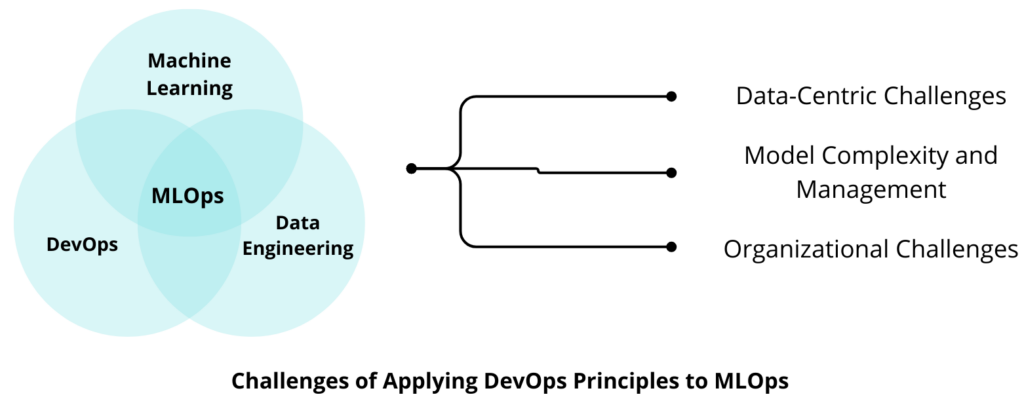
Data-Centric Challenges
- Data Versioning: Tracking changes in data over time is complex due to data’s volume and velocity. Ensuring data consistency and reproducibility across model training and deployment is critical.
- Data Quality: Maintaining high data quality is essential for model performance. Identifying and addressing data issues, such as missing values, outliers, and inconsistencies, is time-consuming.
- Data Privacy and Security: Handling sensitive data requires robust security measures and compliance with regulations. Balancing data accessibility for model training with privacy concerns is a delicate task.
Model Complexity and Management
- Model Reproducibility: Recreating the exact environment for model training and deployment can be challenging due to numerous dependencies and hyperparameters.
- Model Versioning: Tracking different versions of models and their corresponding datasets is crucial for experimentation and rollback.
- Model Deployment and Scaling: Deploying models into production and scaling them to handle varying workloads requires specialized infrastructure and orchestration.
Organizational Challenges
- Cultural Transformation: Shifting from a siloed to a collaborative environment requires a change in mindset and processes.
- Skill Gap: Finding individuals with both data science and DevOps expertise can be challenging.
- Toolchain Integration: Integrating diverse tools for data management, model development, deployment, and monitoring can be complex.
Addressing these challenges requires a combination of technological solutions, process improvements, and organizational changes. By understanding these obstacles and implementing effective strategies, organizations can overcome them and successfully leverage MLOps.
Potential Solutions of Applying DevOps Principles to MLOps
Addressing the challenges inherent in MLOps requires a multifaceted approach that combines technological advancements, process improvements, and organizational changes. By implementing the following strategies, organizations can enhance their MLOps capabilities and achieve optimal results.
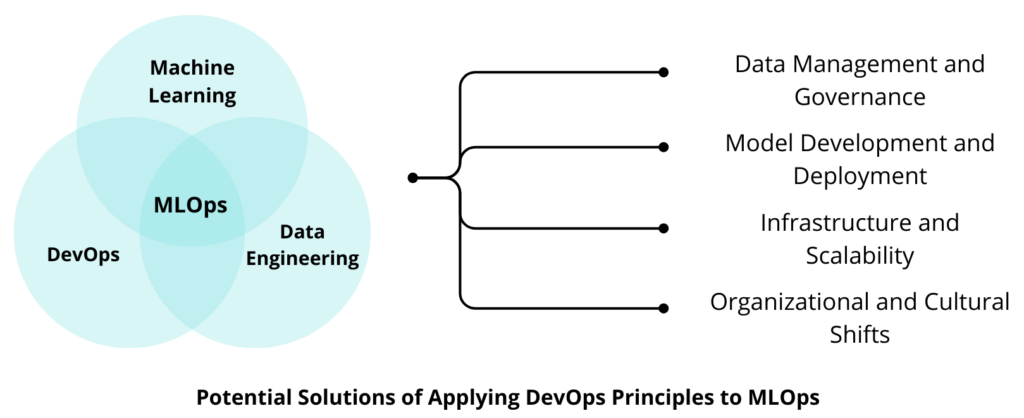
Data Management and Governance
- Data Quality Pipelines: Establish robust data pipelines to ensure data accuracy, consistency, and completeness throughout the ML lifecycle.
- Data Version Control: Implement tools like DVC (Data Version Control) to track data changes and maintain reproducibility.
- Data Privacy and Security: Prioritize data protection by adhering to regulations like GDPR and CCPA while enabling data access for model training.
Model Development and Deployment
- Model Registry: Create a centralized repository for managing and versioning ML models.
- Model Explainability: Utilize techniques like LIME and SHAP to understand model decisions and build trust.
- MLOps Platforms: Leverage platforms like MLflow, Kubeflow, or Azure ML to streamline the ML workflow.
- Continuous Integration and Continuous Delivery (CI/CD) for ML: Automate the build, test, and deployment of ML pipelines.
Infrastructure and Scalability
- Cloud-Native MLOps: Utilize cloud platforms for scalable and cost-effective ML infrastructure.
- Containerization: Package ML models and dependencies into containers for efficient deployment.
- Orchestration: Employ tools like Kubernetes to manage and scale ML workloads.
Organizational and Cultural Shifts
- Cross-Functional Teams: Foster collaboration between data scientists, engineers, and operations teams.
- Data-Driven Culture: Create a culture that prioritizes data and insights.
- MLOps Training and Development: Invest in upskilling employees on MLOps practices and tools.
- MLOps Metrics: Define and track key performance indicators (KPIs) to measure MLOps success.
By systematically addressing these challenges and implementing the proposed solutions, organizations can overcome the hurdles associated with MLOps and unlock its full potential.
How to Bridge the Gap Between MLOps and DevOps
Bridging the gap between MLOps and DevOps requires a strategic approach that focuses on collaboration, toolchain integration, and process optimization. By adopting the following strategies, organizations can create a unified and efficient pipeline for delivering both software and AI-powered solutions.
Shared Toolchains and Platforms
- Leverage cloud platforms: Cloud providers offer a range of tools and services that support both MLOps and DevOps, such as AWS, Azure, and GCP. These platforms provide managed services for infrastructure, data storage, compute resources, and ML frameworks, facilitating collaboration and reducing operational overhead.
- Adopt containerization: Utilize containers to package applications and their dependencies, enabling consistent deployment across different environments. Containers provide a standardized way to package and deploy both software and ML models, promoting consistency and portability.
- Implement CI/CD pipelines: Create unified CI/CD pipelines that encompass both software and ML model development, testing, and deployment. This ensures a seamless flow from code to production for both software and AI components.
Cross-Functional Teams
- Foster collaboration: Encourage knowledge sharing and collaboration between data scientists, engineers, and operations teams. Cross-functional teams can break down silos and accelerate project delivery.
- Shared responsibilities: Define clear roles and responsibilities for team members involved in MLOps and DevOps. This avoids overlaps and ensures efficient resource allocation.
- Skill development: Invest in training and upskilling employees to bridge the gap between the two disciplines. Provide opportunities for team members to learn about each other’s roles and responsibilities.
Data-Centric Approach
- Data as a first-class citizen: Treat data as a valuable asset and integrate data management practices into the MLOps lifecycle.
- Data governance: Establish data governance policies to ensure data quality, security, and compliance.
- Data version control: Utilize tools like DVC to track data changes and enable reproducibility.
Model Governance and Risk Management
- Model registry: Create a centralized repository for managing and versioning ML models.
- Model monitoring: Continuously monitor model performance and detect drift.
- Model retraining: Implement automated retraining pipelines to maintain model accuracy.
- Risk assessment: Identify and mitigate potential risks associated with ML models.
Metrics and KPIs
- Define shared metrics: Establish metrics that measure the success of both MLOps and DevOps initiatives.
- Track key performance indicators: Monitor metrics such as deployment frequency, lead time, mean time to recovery (MTTR), model accuracy, and data quality.
- Use data-driven insights: Leverage metrics to identify areas for improvement and optimization.
By following these strategies, organizations can effectively bridge the gap between MLOps and DevOps, creating a unified and efficient development and delivery pipeline.
The Future of MLOps and DevOps
The rapid evolution of technology is driving the convergence of MLOps and DevOps, leading to new opportunities and challenges.
AI-Augmented DevOps and MLOps
- Intelligent automation: AI will be used to automate repetitive tasks within DevOps and MLOps pipelines, such as incident response, infrastructure provisioning, and model retraining.
- Predictive analytics: AI-powered predictive models will forecast system performance, identify potential issues, and optimize resource allocation.
- Generative AI: AI will be used to generate code, test cases, and even parts of ML models, accelerating development cycles.
Cloud-Native Everything
- Serverless architectures: Both DevOps and MLOps will increasingly leverage serverless computing for scalability and cost efficiency.
- Kubernetes as the control plane: Kubernetes will become the de facto standard for managing and orchestrating both software and ML workloads.
- Cloud-based MLOps platforms: Specialized platforms will emerge to streamline ML model development, deployment, and management.
DevSecOps and MLSecOps
- Security by design: Security will be integrated into DevOps and MLOps from the outset, rather than being an afterthought.
- AI-powered security: AI will be used to detect and respond to security threats.
- Privacy-preserving technologies: Techniques like differential privacy and federated learning will be essential for protecting sensitive data.
Low-Code/No-Code and Citizen Development
- Democratization of MLOps: Low-code/no-code tools will empower a broader range of users to build and deploy ML models.
- Citizen data scientists: Business users will be able to leverage AI without extensive coding knowledge.
Conclusion
MLOps and DevOps are not competing methodologies but rather complementary approaches to software and AI development. Both share the common goal of accelerating delivery, improving quality, and increasing efficiency. By understanding the nuances of each discipline and leveraging their strengths, organizations can create a unified and robust development pipeline.
MLOps extends DevOps principles to address the unique challenges of machine learning, such as data management, model experimentation, and deployment. While DevOps focuses on the software development lifecycle, MLOps encompasses the entire machine learning lifecycle.
The future lies in the convergence of MLOps and DevOps, with increased automation, AI-driven insights, and a focus on ethical considerations. By adopting a holistic approach and investing in the necessary tools and talent, organizations can unlock the full potential of both disciplines.
At Codersperhour, we specialize in helping organizations implement effective MLOps and DevOps strategies. Our expertise in data science, software engineering, and cloud technologies enables us to deliver tailored solutions that drive business value. Contact us today to learn how we can help you optimize your development and deployment processes.


